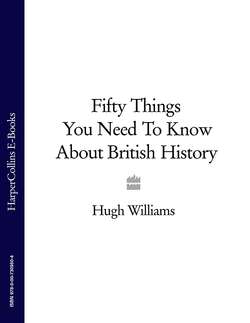Читать книгу Fifty Things You Need To Know About British History - Hugh Williams - Страница 22
The Union Jack
ОглавлениеIn 1606, three years after James I became King of both Scotland and England, a new flag was invented to celebrate the union of the two monarchies. It was to be used solely at sea. A royal decree proclaimed that Britain’s ships ‘shall beare in their Mainetoppe the Red Crosse, commonly called St Georges Crosse, and the White Crosse, commonly called St Andrewes Crosse, joyned together according to a forme made by our Heralds’.
The square blue cross of St Andrew was used as a background with a white border separating the blue bits from the red, as required by the rules of heraldry. The third element of the flag, the red diagonal cross of St Patrick, was added in 1801 after the Act of Union with Ireland. The Welsh flag does not feature in the design at all because Wales was considered to be a principality of England.
The flag was not used during Cromwell’s time as Lord Protector because a new design incorporating the St George and St Andrew crosses, together with a golden harp and Cromwell’s white lion on a black shield, was introduced. The original version was reinstated after the restoration of the monarchy in 1660. The term ‘Jack’ may derive from protective jerkins known as ‘jacks’ or ‘jacques’ which sometimes bore saints’ emblems, although there is also a theory that it refers to King James whose name in Latin is ‘Jacobus’.
The Union Jack became an emblem of the Empire. More than a hundred nations, colonies, dominions or protectorates have included it on their flags at one time or another. Today it can be seen on the flags of Australia, New Zealand, Fiji, Tuvalu and Hawaii.
The creation of a parliament gave back to Scotland some of the sovereignty it had lost in 1707, but tensions with England remained. In 2008 the Scottish National Party, which advocates complete independence for Scotland, secured enough votes to form the minority administration of the Scottish Executive. Meanwhile voices in England were beginning to say that it was unfair for Scotland to return MPs to Westminster who then had a say in English affairs, while the House of Commons had no jurisdiction over most internal issues relating to Scotland. Their concerns were framed in a question that had been asked in the House of Commons thirty years before. ‘For how long will English constituencies and English Honourable Members tolerate,’ asked the MP, Tam Dalyell, ‘Honourable Members from Scotland, Wales and Northern Ireland exercising an important, and probably often decisive, effect on British politics while they themselves have no say in the same matters in Scotland, Wales and Northern Ireland?’
The question stands unanswered. When the Chancellor of Scotland, James Ogilvy, Earl of Seafield, signed the Act of Union in 1707 he remarked wistfully: ‘There’s ane end of ane auld song.’ Two hundred years later echoes of the old song can still be heard in Scotland: perhaps his lordship spoke too soon.
